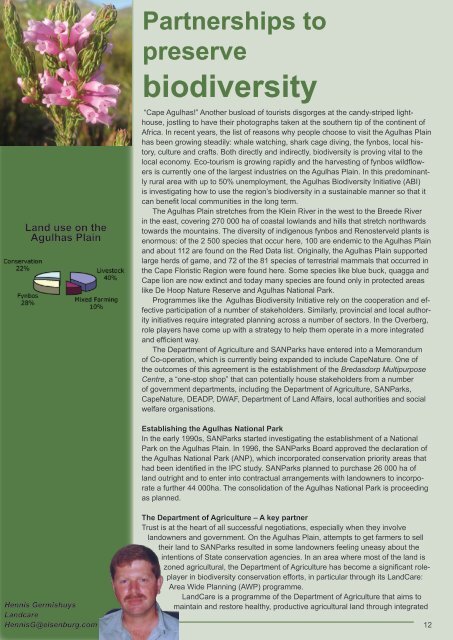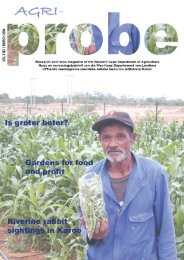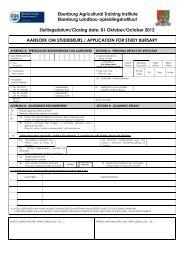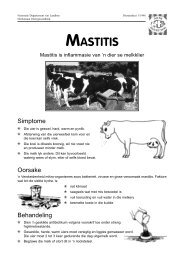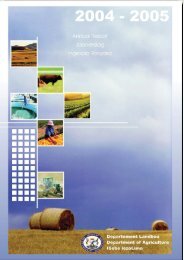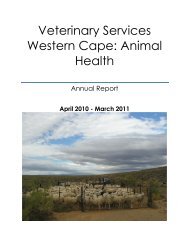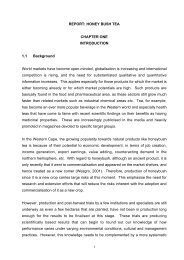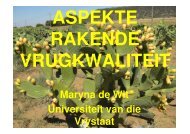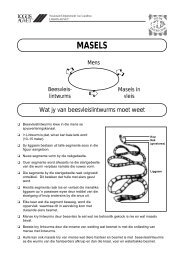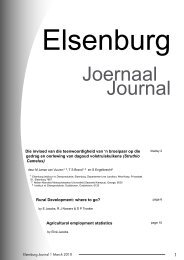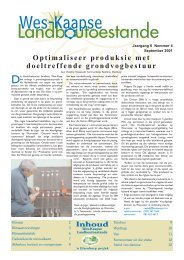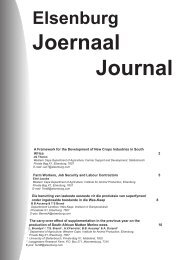Download AgriProbe - Department of Agriculture: Western Cape
Download AgriProbe - Department of Agriculture: Western Cape
Download AgriProbe - Department of Agriculture: Western Cape
Create successful ePaper yourself
Turn your PDF publications into a flip-book with our unique Google optimized e-Paper software.
Land use on the<br />
Agulhas Plain<br />
Hennis Germishuys<br />
Landcare<br />
HennisG@elsenburg.com<br />
AgriPROBE September 2007<br />
Partnerships to<br />
preserve<br />
biodiversity<br />
“<strong>Cape</strong> Agulhas!” Another busload <strong>of</strong> tourists disgorges at the candy-striped lighthouse,<br />
jostling to have their photographs taken at the southern tip <strong>of</strong> the continent <strong>of</strong><br />
Africa. In recent years, the list <strong>of</strong> reasons why people choose to visit the Agulhas Plain<br />
has been growing steadily: whale watching, shark cage diving, the fynbos, local history,<br />
culture and crafts. Both directly and indirectly, biodiversity is proving vital to the<br />
local economy. Eco-tourism is growing rapidly and the harvesting <strong>of</strong> fynbos wildflowers<br />
is currently one <strong>of</strong> the largest industries on the Agulhas Plain. In this predominantly<br />
rural area with up to 50% unemployment, the Agulhas Biodiversity Initiative (ABI)<br />
is investigating how to use the region’s biodiversity in a sustainable manner so that it<br />
can benefit local communities in the long term.<br />
The Agulhas Plain stretches from the Klein River in the west to the Breede River<br />
in the east, covering 270 000 ha <strong>of</strong> coastal lowlands and hills that stretch northwards<br />
towards the mountains. The diversity <strong>of</strong> indigenous fynbos and Renosterveld plants is<br />
enormous: <strong>of</strong> the 2 500 species that occur here, 100 are endemic to the Agulhas Plain<br />
and about 112 are found on the Red Data list. Originally, the Agulhas Plain supported<br />
large herds <strong>of</strong> game, and 72 <strong>of</strong> the 81 species <strong>of</strong> terrestrial mammals that occurred in<br />
the <strong>Cape</strong> Floristic Region were found here. Some species like blue buck, quagga and<br />
<strong>Cape</strong> lion are now extinct and today many species are found only in protected areas<br />
like De Hoop Nature Reserve and Agulhas National Park.<br />
Programmes like the Agulhas Biodiversity Initiative rely on the cooperation and effective<br />
participation <strong>of</strong> a number <strong>of</strong> stakeholders. Similarly, provincial and local authority<br />
initiatives require integrated planning across a number <strong>of</strong> sectors. In the Overberg,<br />
role players have come up with a strategy to help them operate in a more integrated<br />
and efficient way.<br />
The <strong>Department</strong> <strong>of</strong> <strong>Agriculture</strong> and SANParks have entered into a Memorandum<br />
<strong>of</strong> Co-operation, which is currently being expanded to include <strong>Cape</strong>Nature. One <strong>of</strong><br />
the outcomes <strong>of</strong> this agreement is the establishment <strong>of</strong> the Bredasdorp Multipurpose<br />
Centre, a “one-stop shop” that can potentially house stakeholders from a number<br />
<strong>of</strong> government departments, including the <strong>Department</strong> <strong>of</strong> <strong>Agriculture</strong>, SANParks,<br />
<strong>Cape</strong> Nature, DEADP, DWAF, <strong>Department</strong> <strong>of</strong> Land Affairs, local authorities and social<br />
welfare organisations.<br />
Establishing the Agulhas National Park<br />
In the early 1990s, SANParks started investigating the establishment <strong>of</strong> a National<br />
Park on the Agulhas Plain. In 1996, the SANParks Board approved the declaration <strong>of</strong><br />
the Agulhas National Park (ANP), which incorporated conservation priority areas that<br />
had been identified in the IPC study. SANParks planned to purchase 26 000 ha <strong>of</strong><br />
land outright and to enter into contractual arrangements with landowners to incorporate<br />
a further 44 000ha. The consolidation <strong>of</strong> the Agulhas National Park is proceeding<br />
as planned.<br />
The <strong>Department</strong> <strong>of</strong> <strong>Agriculture</strong> – A key partner<br />
Trust is at the heart <strong>of</strong> all successful negotiations, especially when they involve<br />
landowners and government. On the Agulhas Plain, attempts to get farmers to sell<br />
their land to SANParks resulted in some landowners feeling uneasy about the<br />
intentions <strong>of</strong> State conservation agencies. In an area where most <strong>of</strong> the land is<br />
zoned agricultural, the <strong>Department</strong> <strong>of</strong> <strong>Agriculture</strong> has become a significant roleplayer<br />
in biodiversity conservation efforts, in particular through its LandCare:<br />
Area Wide Planning (AWP) programme.<br />
LandCare is a programme <strong>of</strong> the <strong>Department</strong> <strong>of</strong> <strong>Agriculture</strong> that aims to<br />
maintain and restore healthy, productive agricultural land through integrated<br />
12


